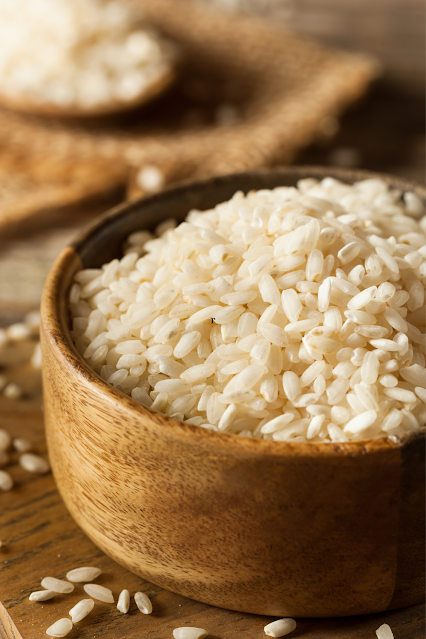Rice is the most produced and consumed cereal in the world after corn, and has been a staple food in many recipes throughout history.
Just
as there has been a great variety of rice recipes in history, there are also
many types of rice with which these recipes are elaborated: black
rice,
red rice,
brown rice, Jasmine
rice,
Roma rice, Vialone
Nano, Ribe or Carnaroli.
Arborio
rice: a round and ideal grain for European gastronomy
Arborio is a rice of Italian origin whose name comes from the town of Arborio, in the Po Valley, where it is grown.
Arborio rice is one of the most used types of rice for the preparation of an
Italian signature dish: risotto.
In this post, we will make a brief review of
Arborio rice, its characteristics, nutritional values, and its uses. Also we will show you an exquisite recipe
with which you will be able to taste this delicious food.
If
you're looking for good quality ingredients, Mahatma Rice offers the best rice
products in market. Enter the next link to see more: https://riceselect.com/product/arborio
All
about Arborio rice and its properties
What are the
main attributes of Arborio rice?
Arborio rice is a hard, rounded, pearly white
grain,
which once cooked becomes a round, firm, creamy and chewy grain. Because of its creaminess and ease of
absorbing a lot of liquid once cooked, this rice is one of the favorite
ingredients for the preparation of risotto.
This
creaminess and absorbency are due to its amylopectin content, a type of starch that represents 18% of the grain's composition. It is often
compared to Carnaroli rice because of its shape and size, although the latter has a higher
amount of starch than Arborio.
What are the
nutritional values of Arborio rice?
The
nutritional values of Arborio rice are similar to the rest. For every 100
grams,
Arborio rice provides about 350 kcal; 6-8 grams of protein, 78 grams of carbohydrates, and between 0.9 and 1.5 grams of fat. As you can read, the major percentage of
its nutritional value is carbohydrates. Also, Arborio rice is considered a
great source of fiber.
In what
recipes can I use Arborio rice?
As
mentioned above, Arborio rice is the most commonly used for the preparation of Risotto thanks
to its silky, creamy, and firm texture. However, this type of rice can be used
to prepare any type of food: sweet rice, broth rice, baked rice, sushi, and desserts such as rice pudding.
In
the case of Paella, although Bomba rice is the most commonly used, Arborio rice is
also an excellent option. Both Arborio and Bomba rice are short-grain
varieties, so they are pretty similar, although the latter is slightly more
absorbent.
The
perfect recipe with Arborio rice as the main ingredient
Here
is a recipe for a delicious lunch with Arborio rice: Butternut
squash risotto.
●
1
oz of unsalted butter.
●
2
tbsp. of olive oil.
●
1
thinly sliced onion.
●
2
finely chopped garlic cloves.
●
10
oz of Arborio rice.
●
7fl
oz of dry white wine.
●
1
pint 16fl oz of vegetable stock (made with stock cubes).
●
1
small (or ½ large) squash of peeled, seeded, and cut into small butternut
cubes.
●
One
handful of thinly sliced small fresh sage leaves.
●
3½
oz of finely grated Parmesan cheese (or similar hard cheese).
●
5
oz of well-drained and cut into small cubes mozzarella balls.
●
1
1⁄4 oz of pine nuts.
●
Salt
and freshly ground black pepper.
1.
Heat
the butter and half of the oil in a skillet over medium-low heat. Add the
onions and garlic and sauté for 8-10 minutes until soft but not discolored. Add
the rice and cook for 1-2 minutes, stirring constantly, until the rice is
soaked in oil.
2.
Pour
in the wine and bring it to a boil. Reduce the heat slightly until the wine
begins to boil, then simmer until two-thirds of the wine has evaporated.
3.
Add
a ladleful of hot stock to the pan and bring it back to a boil. Turn
off the heat if the liquid starts to bubble too much so that the rice does not
cook too quickly.
When most of the broth has evaporated, add another tablespoon. Cook the risotto
in this manner for 12-15 minutes or until the rice has absorbed most of the
stock and is tender but lightly seasoned. Meanwhile, heat the remaining oil in a skillet over medium heat
and fry the squash for 10-12 minutes, occasionally turning, until soft and
golden brown on all sides.
4.
Add
sage, squash, Parmesan cheese, and mozzarella to the risotto. Turn off the
heat, place the skillet on the stove and allow the cheese to melt. Season to
taste with salt and pepper. Meanwhile, heat a dry skillet over medium heat, add
the pine nuts, and toast until golden brown or for 1 or 2 minutes. Add them to
the risotto to serve.
●
It
may not be necessary to use all of the broth, as the goal is for the rice to be
loose and not dry.
●
It
should be cooked slowly and the liquid or broth should be added little by
little. If you cook it in abundant water like traditional white rice, you
will not get that creaminess.
Remember that this variety absorbs a lot of water.
●
Contrary to the Paella, it must be stirred
constantly.
Do not let it rest because the amount of starch it has released will make it
sticky and hard.
●
You
can vary the flavor of your risotto by adding different ingredients. Try
substituting cooked ham and peas for the butternut and the sage. If you add
harder vegetables, you may need to precook them first.
●
It is crucial not to wash the rice before
cooking,
so as not to lose the amount of starch it contains and thus achieve a creamy
texture.











My kids love this dish.
ReplyDelete